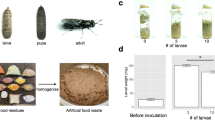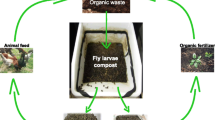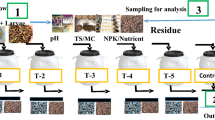Abstract
Black soldier fly (BSF) larvae (Hermetia illucens), feeding on leachate from decaying vegetable and food scrap waste, increase ammonia (NH +4 ) concentration five- to sixfold relative to leachate unprocessed by larvae. NH +4 in larva-processed leachate reached levels as high as ∼100 mM. Most of this NH +4 appears to have come from organic nitrogen within the frass produced by the larvae as they fed on leachate. In nitrate-enriched solutions, BSF larvae also facilitate dissimilatory nitrate reduction to ammonia. The markedly higher concentration of NH +4 recovered in leachates processed with BSF larvae and concomitant diversion of nutrients into insect biomass (itself a valuable feedstock) indicate that the use of BSF larvae in processing leachate of decaying organic waste could be advantageous in offsetting capital and environmental costs incurred in composting.




Similar content being viewed by others
References
Batzli, J. M., & Dawson, J. O. (1999). Canadian Journal of Botany, 77, 1373–1377.
Berridge, M. J. (1965). Journal of Experimental Biology, 43, 535–552.
Bondari, K., & Sheppard, D. C. (1987). Aquaculture and Fisheries Management, 18, 209–220.
Brown, A. W. A. (1938). Biochemical Journal, 32, 895–902.
Brown, A. W. A. (1938). Biochemical Journal, 32, 903–912.
Burgin, A. J., & Hamilton, S. K. (2007). Frontiers in Ecology and the Environment, 5, 89–96.
Conrad, R. (1996). Microbiological Reviews, 60, 609–640.
Diaz, L. F., & Trezek, G. J. (1979). Compost Science and Land Utilization, 20, 27–30.
Diener, S., et al. (2011). In M. Alamgir, et al. (Eds.). Proc. Waste Safe—2nd International Conference on Solid Waste Management in the Developing Countries, Khulna, Bangladesh, pp.52.
Escalante-Semerena, J. C., Blakemore, R. P., & Wolfe, R. S. (1980). Applied and Environmental Microbiology, 40, 429–430.
Green, T. R., & Popa, R. (2011). Applied Biochemistry and Biotechnology, 165, 270–278.
Hale, O. L. (1973). Journal of the Georgia Entomological Society, 8, 16–20.
Hem, S., Toure, S., Sagbla, C., & Legendre, M. (2008). African Journal of Biotechnology, 7, 1192–1198.
Hunter, M. D. (2001). Agricultural and Forest Entomology, 3, 77–84.
Jenkins, D. (1967). Advances in Chemistry Series, 73, 265–280.
Krogmann, U., & Woyczechowski, H. (2000). Waste Management & Research, 18, 235–248.
Li, Q., et al. (2011). Fuel, 90, 1545–1548.
Mattson, W. J., & Addy, N. D. (1975). Science, 190, 515–522.
Myers, H. M., et al. (2008). Environmental Entomology, 37, 11–15.
Newton, G. L., et al. (1977). Journal of Animal Science, 44, 395–400.
Popa, R., & Green, T. R. (2011). Insects, leachates and the recycling of nutrients. Journal of Economic Entomology. (in press).
Ro, K. S., Choi, H. M., & Tsai, F. J. (1997). Journal of the Environmental Science and Health, Part A, 32, 367–390.
Robinson, W. (1935). Journal of Parasitology, 21, 354–358.
Sealey, W. M., et al. (2011). Journal of the World Aquaculture Society, 42, 34–45.
Serraj, R., Sinclair, T. R., & Purcell, L. C. (1999). Journal of Experimental Botany, 50, 143–155.
Sheppard, D. C., et al. (2002). Journal of Medical Entomology, 39, 695–698.
St-Hilaire, S., et al. (2007). Journal of the World Aquaculture Society, 38, 59–67.
Swank, W. T., et al. (1981). Oecologia, 51, 297–299.
Tiedje, J. M. (1988). In A. J. B. Zehnder (Ed.), Environmental microbiology of anaerobes (pp. 179–244). New York: Wiley.
Van Wijnen, H., Van der Wal, R., & Bakker, J. P. (1999). Oecologia, 118, 225–231.
Veraart, A. J., de Klein, J. J. M., & Scheffer, M. (2011). PLoS One, 6, e18508.
Wigglesworth, V. B. (1931). Journal of Experimental Biology, 8, 443–451.
Author information
Authors and Affiliations
Corresponding author
Rights and permissions
About this article
Cite this article
Green, T.R., Popa, R. Enhanced Ammonia Content in Compost Leachate Processed by Black Soldier Fly Larvae. Appl Biochem Biotechnol 166, 1381–1387 (2012). https://doi.org/10.1007/s12010-011-9530-6
Received:
Accepted:
Published:
Issue Date:
DOI: https://doi.org/10.1007/s12010-011-9530-6




